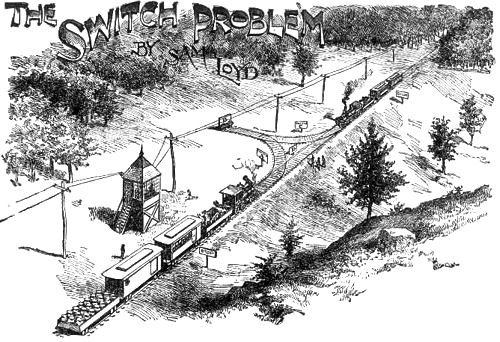



THIS IS A PRACTICAL problem for railroad men, given to illustrate some of the complications of every-day affairs and is based upon the reminiscences of the days when railroading was in its infancy, before the introduction of double tracks, turn tables or automatic switches. Yet, I am not going back to the days of our great grandfathers, for there are those among us who are familiar with the advent of the iron horse, and the good lady who furnished me with the subject matter of this puzzle based it upon personal experience of what she called “the other day.”
To tell the story in her own way. She said:
“We had just arrived at the switch station, where the trains always pass, when we found that the Limited Express had broken down. I think the conductor man said the smokestack had got hot and collapsed, so there was no draught to pull it off the track.”
The picture shows the Limited Express, with its collapsed engine, and the approach of the accommodation train from Wayback, which by some means or other, must pass the stalled train
The problem being to make the two trains pass, it is understood that no ropes, poles, flying switches, etc. are to be employed; it is a switch puzzle pure and simple. The object being to get the accommodation train past the wreck and leave the latter train and each of its cars in the position as shown in the sketch. It is necessary to say that upon the side switch there is but room enough for one car or engine, which is also true of the sections of the switch marked A, B. C or D.
The problem is to tell just how many times the engineer must reverse; that is, change the direction of his engine to perform the feat. Of course the broken-down engine can not be used as a motor, but must, be pushed or pulled along just as if it were a car. The cars may be drawn singly or coupled together in any required numbers.
The problem complies with the ordinary rules of practice and is given to test your ingenuity and cleverness in discovering the quickest possible way Lo pass the broken down train.
The problem is solved in thirty-two moves, as follows: First engine F passes alone through the switch via C, B, A (two moves), pulls engine E to D and once more passes through switch via C, B, A (total, five moves); pulls car D to D, pushing E. out to right; passes again through switch (eight moves); pulls G to D, pushing others out to right, engine goes through switch again (eleven moves); pulls B to D, and passes through switch as before (fourteen moves ; pulls A to D and passes through switch for the last time (seventeen moves); goes to right, then draws A, B, C, D, E, G to left and backs G onto switch (twenty moves): draws A. B, C, D, E to left, backs them to right (twenty-two moves); goes to left alone, backs up on switch at A and takes G to left (twenty-four moves); goes to right, then pulls everything out to left, backs H, I onto switch (twenty-seven moves); pulls G. A, B, C, D, E out to left, backs them to right, then takes F to right and backs up to switch and connects G to H, I (thirty-one moves), and is now prepared to go ahead on the thirty-second move.
2.
What is the difference between a lady and an apple? One you have to get side her to squeeze, and the other you have to squeeze to get cider.
Who is the greatest chicken-killer spoken of in Shakespeare? Macbeth, because he did murder most foul.
Why is music cheaper on Sunday than during the week? Because during the week you get it by piece, and on Sunday you get it by the choir.
Which death would you prefer to die, Joan of Arc’s or Mary Stuart’s? Most people prefer Joan of Arc’s, because they like a hot steak better than a cold chop.
If you were invited out to dinner and on sitting down to the table saw nothing put a beet, what would you say? That beet’s all.
When is charity like a top? When it begins to hum.
Why is a man sometimes like dough? Not because a woman needs (kneads) him, but because he is hard to get off of her hands.
Why are a dead duck and a dead doctor alike? Because they have both stopped quacking.
[Page 167]